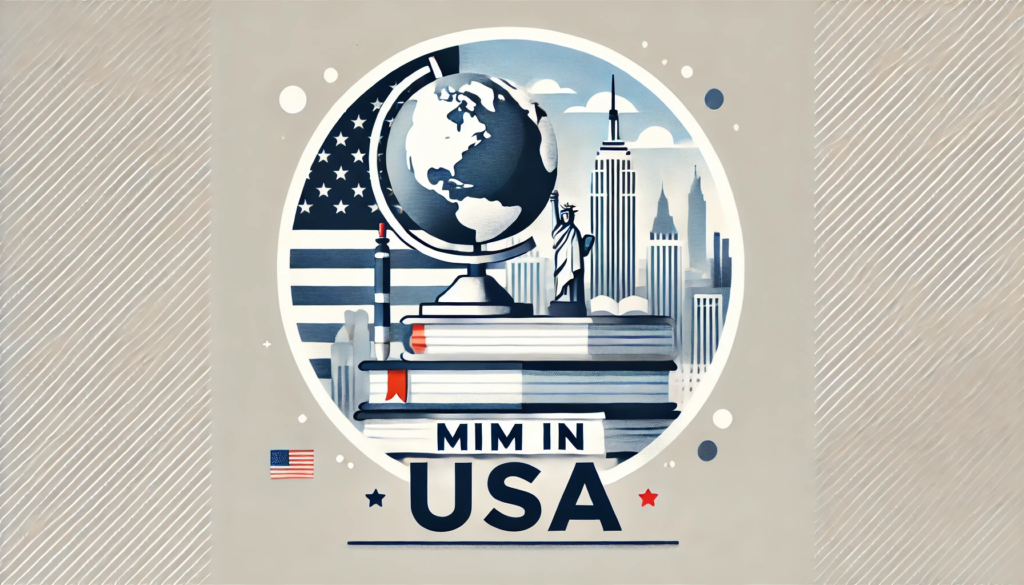If you’re exploring graduate degrees in management, you might wonder why a MiM in USA has become such a sought-after choice. A Master in Management (MiM) is a specialized degree designed for individuals at the start of their professional journeys, offering rigorous academic training combined with practical business acumen. While MiM programs originated in Europe, the MiM in USA has rapidly emerged as a top destination due to its globally recognized universities and strong career outcomes.
The USA offers unparalleled access to leading industries, particularly in fields like technology, consulting, and finance. Graduates of MiM in USA often find themselves in high-demand roles, leveraging the vast alumni networks and brand recognition of institutions like Duke University or Northwestern University. Moreover, many MiM in USA programs integrate a STEM designation, which is especially beneficial for international students. This designation not only enhances the curriculum with a focus on analytics and technology but also allows for an extended Optional Practical Training (OPT) period, enabling students to work in the USA for up to three years post-graduation.
With rising global interest, studying a MiM in USA combines the prestige of an American degree with practical, career-focused training. This guide will provide you with everything you need to know, from admission requirements to selecting the right program and maximizing your investment in this transformative degree.
Key Takeaways
- Top MiM Programs in the USA: Leading schools like Duke Fuqua, Northwestern Kellogg, USC Marshall, Michigan Ross, and Boston Questrom offer world-class MiM programs focused on leadership and hands-on learning.
- STEM-Designated MiM Programs: Programs like Boston University’s MiM integrate analytics and tech skills, boosting employability in data-driven industries.
- Career Outcomes for MiM in USA: Graduates secure roles in consulting, finance, and tech, with average starting salaries ranging from $70,000 to $100,000.
- Admission Requirements for MiM in USA: Strong academics, competitive GMAT/GRE scores, TOEFL/IELTS proficiency, and WES evaluations are often required.
- Experiential Learning in MiM Programs: Internships, capstone projects, and global exposure ensure students gain practical industry experience.
- ROI of MiM in USA: Top MiM programs offer strong returns on investment, combining career growth, global networks, and leadership development.
Best MiM in USA Colleges: Top-Ranked Universities
1. Duke University – Fuqua School of Business
Duke University’s Fuqua School of Business is renowned for its rigorous academic environment, global reputation, and strong focus on leadership development. The Master of Management Studies (MMS) program at Fuqua provides a well-rounded foundation in core business disciplines, tailored for students aiming to kickstart their management careers. The program emphasizes experiential learning through practical consulting projects and collaborative teamwork, preparing students for real-world challenges. Fuqua’s diverse student body fosters a rich exchange of ideas, enhancing the global perspective of its graduates.

| Factor | Data |
|---|---|
| Acceptance Rate | ~25% |
| US News Ranking | #13 for Business Schools |
| Tuition Fees | $58,000 (approx.) |
| Additional Expenses | $25,000 (living, materials, etc.) |
| Test Scores Required | GMAT: 650+ or GRE equivalent |
| Average Post-Salary | $75,000–$85,000 |
| Notable Alumni | Tim Cook (CEO of Apple) |
2. Northwestern University – Kellogg School of Management
Northwestern’s Kellogg School of Management is a powerhouse for leadership and innovation, consistently ranked among the world’s top business schools. Its MiM program focuses on core management principles, offering a dynamic mix of theoretical knowledge and practical applications. What makes Kellogg stand out is its elective options, allowing MiM students to take courses alongside MBA peers, creating unparalleled networking opportunities. Located near Chicago, the program leverages proximity to major corporate hubs, ensuring exceptional internship and job placement opportunities.

| Factor | Data |
|---|---|
| Acceptance Rate | ~30% |
| US News Ranking | #4 for Business Schools |
| Tuition Fees | $64,000 (approx.) |
| Additional Expenses | $30,000 (living, materials, etc.) |
| Test Scores Required | GMAT: 680+ or GRE equivalent |
| Average Post-Salary | $80,000–$100,000 |
| Notable Alumni | Sundar Pichai (CEO of Alphabet) |
3. University of Southern California – Marshall School of Business
The Master of Science in Management Studies at USC’s Marshall School of Business is a highly customizable program designed for students with minimal work experience. Located in Los Angeles, the program combines a rigorous curriculum with opportunities to engage with industries such as entertainment, technology, and finance. USC’s strong industry connections and dedicated career services ensure graduates are well-prepared for competitive job markets. The program’s cohort diversity and emphasis on global perspectives make it particularly appealing for international students.

| Factor | Data |
|---|---|
| Acceptance Rate | ~35% |
| US News Ranking | #15 for Business Schools |
| Tuition Fees | $62,000 (approx.) |
| Additional Expenses | $28,000 (living, books, etc.) |
| Test Scores Required | GMAT: 640+ or GRE equivalent |
| Average Post-Salary | $70,000–$85,000 |
| Notable Alumni | Marc Benioff (CEO of Salesforce) |
4. University of Michigan – Ross School of Business
The Master of Management program at the University of Michigan’s Ross School of Business is a top-tier choice for students looking to accelerate their careers. Known for its collaborative culture and action-based learning approach, the Ross MiM program integrates case studies and hands-on projects into the curriculum. Situated in Ann Arbor, the program offers access to a vibrant academic environment and extensive alumni network. Graduates benefit from strong placement records, particularly in consulting, finance, and tech sectors.

| Factor | Data |
|---|---|
| Acceptance Rate | ~27% |
| US News Ranking | #10 for Business Schools |
| Tuition Fees | $55,000 (approx.) |
| Additional Expenses | $22,000 (living, health insurance, etc.) |
| Test Scores Required | GMAT: 650+ or GRE equivalent |
| Average Post-Salary | $75,000–$90,000 |
| Notable Alumni | Larry Page (Co-Founder of Google) |
5. Boston University – Questrom School of Business
Boston University’s Questrom School of Business offers a cutting-edge Master in Management program with a STEM designation. The program is tailored to students aiming for roles in analytics-driven industries, blending management principles with technical expertise. Located in the heart of Boston, Questrom offers students unparalleled opportunities to connect with companies in industries like biotech, healthcare, and finance. Its focus on innovative teaching methods ensures graduates are ready for the challenges of a data-driven world.

| Factor | Data |
|---|---|
| Acceptance Rate | ~40% |
| US News Ranking | #20 for Business Schools |
| Tuition Fees | $54,000 (approx.) |
| Additional Expenses | $24,000 (living, materials, etc.) |
| Test Scores Required | GMAT: 630+ or GRE equivalent |
| Average Post-Salary | $70,000–$85,000 |
| Notable Alumni | Sumner Redstone (Media Mogul) |
Understanding MiM in USA Requirements

Applying to a MiM in USA requires meticulous preparation, as the eligibility criteria can vary significantly between institutions. However, most programs share common expectations when it comes to academic performance, test scores, and documentation.
To start, a recognized undergraduate degree is essential. Many universities require a GPA of at least 3.0 on a 4.0 scale, equivalent to around 7.5–8.0 on the Indian CGPA system. If your degree uses a different grading standard, such as a percentage scale, institutions often recommend using credential evaluation services like WES (World Education Services). This ensures that your academic credentials are accurately understood by admissions committees, especially for applicants with 3-year bachelor’s degrees.
English language proficiency tests like the TOEFL or IELTS are mandatory for students from non-English-speaking countries. A minimum TOEFL score of 100 or an IELTS score of 7.0 is typically required, though some universities may consider conditional waivers for students with prior education in English.
While work experience is not mandatory for most MiM programs, a strong internship or part-time work profile can significantly strengthen your application. This demonstrates initiative, real-world experience, and a proactive approach to career development—qualities highly valued by admissions committees.
Finally, international applicants must pay attention to documentation requirements, particularly the WES evaluation. Schools like Boston University and Duke University insist on this evaluation to verify the equivalency of non-US degrees. Submitting an incomplete or inaccurate credential evaluation can delay or derail your application process.
Exploring the MiM Course in USA
The curriculum of a MiM in USA is designed to equip students with the essential skills needed to thrive in diverse management roles. While the specific course structure varies by institution, most programs focus on combining theoretical knowledge with practical application through case studies, internships, and networking opportunities.
Core Curriculum and Learning Outcomes
At the heart of every MiM program are foundational subjects that cover key aspects of business and management. Commonly, these include courses in management theory, marketing, corporate finance, organizational behavior, and business strategy. These subjects are tailored to provide a holistic understanding of how businesses operate and equip students with the analytical tools needed to solve complex problems.
Many MiM programs, especially those at top institutions like Northwestern University or Duke University, also emphasize soft skills such as leadership, communication, and teamwork. These are cultivated through group projects, leadership workshops, and real-world consulting opportunities. Additionally, students are often exposed to global business perspectives, helping them understand how cultural and economic factors influence business decisions.
What sets MiM in USA programs apart is their integration of STEM elements, especially in STEM-designated courses. These programs include modules like data analytics, operations research, and quantitative decision-making, aligning the curriculum with the growing demand for tech-savvy managers in industries like technology, consulting, and finance. For example, Boston University’s STEM-designated MiM program integrates analytics courses that prepare students for roles in tech-focused environments.
Experiential Learning Opportunities
Experiential learning is a cornerstone of MiM in USA. Through internships, capstone projects, and global immersion opportunities, students gain hands-on experience that complements classroom instruction. These practical experiences are particularly valuable for international students who seek exposure to US business practices and corporate culture.
Internships, in particular, are a significant advantage of pursuing a MiM in USA. Schools often collaborate with leading companies to place students in roles that align with their career aspirations. For example, graduates from STEM-designated MiM programs often find internships in Fortune 500 companies or emerging startups, working in roles that bridge management and technology.
Program Length and Flexibility
Most MiM in USA are designed to be completed within 10 to 24 months. This duration varies based on the intensity of the curriculum and whether the program includes optional internships or co-op opportunities. Some schools also offer part-time or accelerated tracks, providing flexibility for students with different career timelines.
Career Outcomes and Skill Development
Graduates of MiM in USA are well-prepared for leadership roles in various industries. The emphasis on skill development, combined with practical exposure, ensures that students can seamlessly transition into roles in consulting, financial services, marketing, or operations. According to data from top programs, the average starting salary for MiM graduates in the USA ranges from $70,000 to $100,000, depending on the industry and location.
The curriculum’s focus on fostering both technical and interpersonal skills makes US MiM graduates highly attractive to employers. A STEM-designated MiM, in particular, significantly boosts employability by positioning graduates as versatile professionals capable of blending managerial insights with analytical expertise.
Is MiM from USA Really Worth It?
When considering a Master in Management (MiM) program in the USA, it’s natural to ask whether the investment of time and money will pay off in the long run. The answer depends on your career aspirations, the program you choose, and how effectively you leverage the opportunities it provides.
Return on Investment (ROI)
One of the most compelling reasons to pursue a MiM in USA is the significant return on investment. Graduates from top programs like Kellogg, Duke, and USC often secure high-paying roles in consulting, technology, and finance. According to recent data, starting salaries for MiM in USA graduates typically range from $70,000 to $100,000, with elite institutions reporting even higher averages. Moreover, the global reputation of US universities ensures that your degree remains a valuable asset throughout your career, regardless of where you work.
Long-Term Benefits
A MiM in USA doesn’t just offer immediate job opportunities—it sets the foundation for a successful career. Graduates often find that the analytical and leadership skills gained during their MiM studies continue to be relevant as they advance into mid-level and senior roles. Additionally, the strong alumni networks of US universities can provide lifelong mentorship and networking opportunities, opening doors to prestigious roles and organizations.
Risks to Avoid
While the benefits are clear, it’s crucial to approach your MiM in USA journey strategically. Not all programs in the USA offer the same value. Tier 2 or Tier 3 institutions may lack the reputation, industry connections, or career support needed to secure high-paying roles. Students must carefully research programs, prioritize those with strong placement records, and align their choices with their career goals.
Real-World Example
Consider the case of Priya, an Indian student with a strong undergraduate degree in engineering and a GMAT score of 710. She chose the STEM-designated MiM program at Boston University. During her studies, she interned at a biotech firm in Boston and, upon graduation, secured a full-time role as a data analyst with a starting salary of $85,000. This trajectory highlights how the right program and proactive career planning can lead to exceptional outcomes.
How to Achieve the Best MiM in USA: Tips for Admission Success
Frustrated with Generic College Lists from AI Tools?
Get a tailored college shortlist crafted by study abroad experts who understand YOUR goals, profile, and aspirations.

Securing admission to a top-ranked MiM in USA requires a well-thought-out approach. With competition for seats intensifying each year, crafting a strong application is essential to stand out. Here are some actionable tips to help you succeed:
1. Start Early and Research Extensively
Begin your preparation at least a year before the application deadline. This gives you ample time to research programs, understand their unique offerings, and identify those that align with your career goals. Top programs like those at Kellogg, Duke, and USC often have specific requirements and application timelines, so being well-informed is crucial.
2. Build a Strong Academic Profile
Your academic record is a key component of your application. Aim for a GPA equivalent to 3.0 or higher on a 4.0 scale. If your undergraduate GPA is lower, consider balancing it with a strong GMAT or GRE score. For top programs, a GMAT score of 650+ is typically competitive, with some schools requiring scores above 700 for consideration. For Indian students, obtaining a WES evaluation can add credibility to your academic credentials, particularly for 3-year undergraduate degrees.
3. Craft a Compelling Statement of Purpose (SOP)
Your SOP is your opportunity to showcase your unique story, aspirations, and why you’re a perfect fit for the program. Avoid generic statements and focus on what makes you stand out. Highlight your academic achievements, internships, leadership roles, and career goals. Demonstrate a clear connection between your past experiences, the program’s offerings, and your future ambitions. For instance, if applying to a STEM-designated program, emphasize your interest in data-driven decision-making or analytics and how the program aligns with your career aspirations.
4. Secure Strong Letters of Recommendation (LORs)
LORs from professors, employers, or mentors who can vouch for your skills and potential are vital. Ensure that your recommenders understand your goals and can provide detailed examples of your achievements. A strong LOR should reflect your leadership skills, teamwork, and ability to excel in a challenging academic environment.
5. Gain Relevant Experience
Although work experience is not mandatory for most MiM programs, having internships or part-time roles can set you apart. Highlight any experiences that demonstrate your ability to apply theoretical knowledge in real-world scenarios. For example, an internship where you contributed to a marketing strategy or improved operational efficiency adds depth to your application.
6. Leverage GMAT Waivers if Applicable
Many universities offer GMAT waivers for applicants with exceptional academic records or professional certifications. If you qualify, applying for a waiver can save you time and resources. Schools like Georgetown University and Boston University frequently grant waivers for high-performing candidates with strong undergraduate GPAs.
7. Prepare for Interviews
If shortlisted, you’ll likely face an interview as part of the admissions process. Treat the interview as an opportunity to demonstrate your enthusiasm, clarity of purpose, and knowledge of the program. Practice common questions, such as why you chose this program, your career goals, and how you plan to contribute to the school’s community.
Are There Any Non-GMAT MiM Colleges in USA?

For many prospective students, the GMAT can seem like a daunting hurdle. Fortunately, several universities in the USA offer MiM programs without requiring GMAT scores. These options are particularly appealing for applicants with strong academic backgrounds, professional certifications, or relevant work experience that demonstrate their potential without standardized testing.
Schools Offering GMAT Waivers or No GMAT Requirement
Many universities recognize that a candidate’s strengths can extend beyond test scores. Schools such as Georgetown University, Boston University, and the University of Illinois Urbana-Champaign (UIUC) frequently provide GMAT waivers for candidates who meet specific criteria. Waivers are typically granted to applicants with high undergraduate GPAs, exceptional work experience, or professional certifications like CFA Level 1 or CPA.
Additionally, some programs do not require the GMAT at all, focusing instead on holistic application reviews. These schools assess factors like academic performance, Statement of Purpose (SOP), Letters of Recommendation (LORs), and relevant work experience.
Criteria for GMAT Waivers
Here are the common criteria for GMAT waivers at top MiM in USA programs:
- Strong Academic Background: A GPA of 3.4/4.0 (or equivalent) or higher is often sufficient to request a waiver.
- Professional Certifications: Credentials like CFA Level 1, CPA, or other relevant qualifications can bolster waiver applications.
- Relevant Work Experience: Internships or roles that showcase leadership and problem-solving abilities can strengthen your case.
- Exceptional Undergraduate Achievements: Awards, research publications, or high distinction in your field of study.
For example, Boston University’s Questrom School of Business offers GMAT waivers for candidates with an undergraduate GPA of 3.5 or higher or those with significant professional achievements.
List of Notable Non-GMAT or GMAT-Waiver Programs
| University | Waiver Criteria | Program Highlights |
|---|---|---|
| Georgetown University | GPA ≥ 3.4, strong SOP, LORs | Holistic admissions approach, STEM option |
| Boston University – Questrom | GPA ≥ 3.5 or work experience | STEM-designated MiM, analytics focus |
| University of Illinois Urbana-Champaign (UIUC) | GPA ≥ 3.0, CFA certification preferred | Flexible curriculum, STEM-designated |
| Northeastern University | GPA ≥ 3.25 or work experience | Co-op opportunities, strong tech focus |
| Loyola Marymount University | Holistic review, no GMAT required | Small cohorts, personalized career support |
The Importance of a Holistic Profile
While GMAT waivers are appealing, students must focus on building a compelling overall application. Admissions committees at non-GMAT schools place significant emphasis on other components like your SOP, LORs, and academic transcripts. Ensure that your essays articulate your career goals and how the program aligns with them, while your recommendations highlight your unique strengths.
STEM MiM Programs in USA
A growing number of MiM in USA are now designated as STEM (Science, Technology, Engineering, and Mathematics). This designation has significant implications for both the curriculum and career prospects of international students. STEM MiM programs are particularly popular among candidates looking to combine traditional management studies with technical and analytical skills, a blend that is highly sought after in today’s job market.
What is a STEM Designation and Why Does it Matter?
The STEM designation signifies that a program incorporates substantial coursework in technical or quantitative disciplines, such as data analytics, operations research, or information systems. For international students, the most significant advantage is the ability to work in the USA for up to 36 months post-graduation through the Optional Practical Training (OPT) program. This extended period provides valuable time to gain work experience, build professional networks, and explore career opportunities without the immediate pressure of visa constraints.
Key Features of STEM MiM Programs
STEM MiM programs typically integrate advanced technical coursework into their curricula. Alongside core management subjects like strategy, marketing, and finance, these programs often include classes on data visualization, predictive analytics, and decision science. This combination equips students with the skills required for data-driven decision-making, a critical capability in industries like consulting, technology, and finance.
Top STEM MiM in USA
| University | Program | Key Highlights | Average Salary |
|---|---|---|---|
| Boston University – Questrom | Master’s in Management (STEM) | Focus on analytics, internships, global immersion | $70,000–$85,000 |
| University of Southern California | Master of Management Studies (STEM) | Strong tech focus, internships with Fortune 500 companies | $75,000–$85,000 |
| University of Illinois Urbana-Champaign | MS in Management (STEM) | Emphasis on analytics, operations, and technology | $70,000–$90,000 |
| Duke University – Fuqua | MMS: Foundations of Business (STEM) | Experiential learning, international exposure | $75,000–$85,000 |
| Northeastern University | MS in Management (STEM) | Co-op programs, tech-driven curriculum | $65,000–$80,000 |
Career Benefits of STEM MiM Programs
Graduates of STEM-designated MiM programs find themselves well-positioned for high-demand roles in areas like data analytics, tech consulting, and operations management. Employers value the technical expertise and leadership skills developed in these programs, making graduates attractive candidates for positions such as:
- Data Analyst: Applying quantitative techniques to interpret business data.
- Tech Consultant: Bridging the gap between management and technology in client projects.
- Operations Manager: Streamlining processes to improve efficiency and productivity.
The extended OPT period further enhances employability by allowing international students to gain substantial experience in the US job market.
Who Should Consider a STEM MiM Program?
STEM MiM programs are ideal for students with a background in engineering, technology, or other quantitative fields who want to pivot into management roles without losing their technical edge. These programs are also an excellent choice for those aspiring to work in analytics-heavy roles or industries with a strong focus on technology and innovation.
MiM in USA Fees and Funding Options

Pursuing a Master in Management (MiM) in the USA is a significant financial investment, but it can deliver substantial returns in terms of career growth and earning potential. Understanding the cost breakdown and exploring funding options are crucial steps in planning your journey.
Typical Tuition Fees and Additional Costs
Tuition fees for MiM in USA vary depending on the institution and the program’s duration. On average, tuition ranges from $50,000 to $70,000, with top-tier programs like those at Northwestern University and Duke University on the higher end of the spectrum. In addition to tuition, students should budget for the following:
- Living Expenses: Housing, food, and utilities often cost between $15,000 and $25,000 per year, depending on the city. Metropolitan areas like Boston and Los Angeles tend to be more expensive.
- Health Insurance: Many universities mandate comprehensive health coverage, costing approximately $2,000–$4,000 per year.
- Books and Study Materials: These can add up to $1,000–$2,000 annually.
- Miscellaneous Expenses: Transportation, personal expenses, and other incidentals typically range from $2,000 to $5,000 per year.
Cost Breakdown: Sample Table
| University | Tuition Fees | Living Expenses | Health Insurance | Misc. Costs | Total Estimated Cost |
|---|---|---|---|---|---|
| Duke University – Fuqua | $58,000 | $20,000 | $3,500 | $4,000 | $85,500 |
| Northwestern University – Kellogg | $64,000 | $22,000 | $3,000 | $3,000 | $92,000 |
| Boston University – Questrom | $54,000 | $18,000 | $2,500 | $2,500 | $77,000 |
| University of Illinois Urbana-Champaign | $55,000 | $15,000 | $2,000 | $3,000 | $75,000 |
Funding Options for International Students
For many international students, funding is a critical consideration. Thankfully, several options can help reduce the financial burden:
- Scholarships and Grants: Many universities offer merit-based scholarships, ranging from partial tuition waivers to full funding. For example, Boston University offers scholarships based on academic excellence and leadership potential. It’s important to research and apply early, as these opportunities are often competitive.
- Assistantships: Graduate assistantships, such as teaching or research roles, allow students to earn a stipend while contributing to their field of study. These roles not only offset costs but also enhance your academic experience.
- Student Loans: International students can access loans through private lenders or programs like Prodigy Finance. These loans often require a co-signer or are based on your future earning potential.
- Part-Time Work Opportunities: International students on an F-1 visa can work part-time on campus for up to 20 hours per week, earning additional income to cover living expenses.
- External Scholarships: Organizations like the Fulbright Program or Inlaks Scholarships provide financial support to Indian students studying abroad.
Managing Your Finances Effectively
Budgeting is essential to make the most of your financial resources. Here are some tips:
- Opt for shared housing or university dormitories to reduce living expenses.
- Take advantage of public transportation where available.
- Seek part-time roles early to build up savings.
- Monitor spending on non-essential items and stick to a budget.
Is the Investment Worth It?
While the costs can seem overwhelming, the earning potential of MiM graduates often justifies the expense. With starting salaries ranging from $70,000 to $100,000, many graduates recoup their investment within a few years. Additionally, the networking opportunities, alumni connections, and career support provided by top MiM programs make them a valuable investment in your future.
Quick Checklist Before Starting Your MiM in USA
- Confirm program accreditation and STEM designation.
- Complete WES credential evaluation for your undergraduate degree.
- Ensure your F-1 visa application is in progress with all required documents.
- Research your target program’s strengths and align them with your career goals.
- Build professional connections and enhance your communication skills.
- Create a detailed financial plan to cover tuition and living expenses.
- Update your resume and LinkedIn profile to maximize career opportunities.
FAQs on MiM in USA
Here are answers to some of the most common questions prospective students have about pursuing a MiM in USA. These insights aim to address lingering doubts and provide clarity for your decision-making process.
1. Do I need work experience to apply for a MiM in USA?
Typically, work experience is not a requirement for most MiM in USA. These programs are designed for recent graduates or individuals with minimal work experience. However, having relevant internships or part-time roles can strengthen your application by demonstrating practical exposure and initiative.
2. How long does a MiM in USA take to complete?
Most MiM in USA are designed to be completed within 10 to 24 months, depending on the program structure. Accelerated options or programs with internships may vary in length. Schools like Duke University offer shorter, intensive programs, while others like USC provide more flexible timelines.
3. Is a MiM better than an MBA?
A MiM and an MBA serve different purposes. MiM in USA programs target early-career professionals or recent graduates, focusing on foundational management skills. In contrast, MBA programs cater to experienced professionals seeking advanced leadership roles. If you’re just starting your career, a MiM is a better fit, whereas an MBA is ideal for those with 4–6 years of work experience.
4. Can international students secure jobs after completing a MiM in USA?
Yes, international students often secure jobs after graduating from MiM in USA programs, especially those from top-tier, STEM-designated institutions. The extended OPT period for STEM graduates is a significant advantage, allowing students to work in the USA for up to three years. Many graduates find roles in consulting, tech, or finance with competitive starting salaries ranging from $70,000 to $100,000.
5. What is the average salary after a MiM in USA?
The average starting salary for MiM in USA ranges from $70,000 to $100,000, depending on the school, industry, and location. Graduates from top programs like Kellogg and Duke often earn on the higher end of this spectrum, particularly in industries like consulting and technology.
6. Do all MiM programs require the GMAT?
No, not all MiM programs require the GMAT. Several schools offer GMAT waivers or assess applications holistically. Institutions like Georgetown University and Boston University often waive the GMAT for candidates with exceptional academic records or relevant work experience. Some programs, like those at Loyola Marymount University, do not require GMAT scores at all.
7. Can I apply for scholarships to fund my MiM in USA?
Yes, many universities offer scholarships based on academic merit, leadership potential, or financial need. External scholarships, such as the Fulbright or Inlaks Scholarships, are also available to Indian students. It’s crucial to research and apply for these opportunities early, as they are highly competitive.
8. How can I improve my chances of admission to a top MiM program?
Focus on building a well-rounded application. This includes a strong GPA, competitive GMAT/GRE scores (if required), a compelling Statement of Purpose, and robust Letters of Recommendation. Highlight internships, extracurricular achievements, and leadership roles to showcase your unique strengths.
Conclusion: Why Pursue a MiM in USA?
A Master in Management (MiM) degree in the USA is more than just an academic credential—it’s a gateway to global opportunities, cutting-edge learning, and transformative career growth. From the STEM designations that offer extended work opportunities to the unmatched alumni networks of top-tier schools, a MiM in USA prepares you to excel in today’s competitive job market.
Before you embark on this journey, remember that preparation is key. Research thoroughly, craft a compelling application, and align your program choice with your career goals. Investing time and effort in the process now will pay dividends in the future, as you gain not just a degree but also a world of opportunities.
So, are you ready to take the first step toward your dream of studying a MiM in USA? Start shortlisting programs, preparing your application, and exploring funding options today. The path to success begins with the choices you make now!



